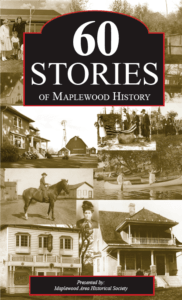60 Stories of Maplewood History

- Year
- 2017
- Creators
- Reviewer: John M. Lindley
- Topics
60 Stories of Maplewood History
Bob Jensen, editor, with Pete Boulay, Nicole DeGuzman, Elaine Ekstedt, Virginia Gaynor, Frank Gilbertson, Brenda Rudberg, Chris Soutter, and Mike Steinmetz
Maplewood, MN: Maplewood Area Historical Society, 2017
125 pages; Softcover; photos and maps; $15.00; order at www.Maplewood Historical Society.org
Over the years, Ramsey County History has tried hard to find and publish accounts that deal with the history of suburban cities, villages, communities, sites, and activities in Ramsey County. Usually these interesting stories find their way into the newsletters and publications of the county’s smaller historical societies, which maintain their local history with great care. Fortunately, the Maplewood Historical Society has published its 60 Stories of Maplewood History, which gathers in one book sixty vignettes that present both the basic details of Maplewood’s history along with colorful accounts of some of the people, places, buildings, and events that are special to that first-tier suburb in Ramsey County.
This book was a collaborative project between the Maplewood Historic Preservation Commission, the Maplewood Area Historical Society, and the City of Maplewood and is divided into seven chapters that deal with the topics of Native Americans and early settlement, agriculture, transportation, cultural life, civic life, commerce and industry, and people and places. Each chapter includes several short stories that report on a place, a person, an event, or a building that is important to Maplewood’s history. The sixty stories were written by the editor and his collaborators. Each story is typically two pages long and includes one or two photos.
The impetus for writing this book was the sixtieth anniversary in 2017 of Maplewood’s incorporation as a village. Although the book gives brief attention to the Native Americans, particularly the Dakota, who lived in the area prior to the time when Euro-Americans began to settle there, most of the history concentrates on the years after 1850. The prairie, oak savannas, and the ready availability of lakes and streams in that area of Ramsey County gave rise to small farms, especially dairy and market-garden (truck) farms, which supplied milk and fresh produce to nearby St. Paul in the days before the widespread use of refrigerated trucks and national supermarket chains. Today, nearly all of these farms are gone, replaced by residential housing, commercial and industrial ventures, the Maplewood Mall, and 3M’s impressive corporate campus adjacent to Interstate 94. Most of this growth occurred after World War II, but to its credit, Maplewood has also made a conscious effort to preserve open spaces and generous park lands.
In 1952‑53, 3M decided to consolidate its corporate office and other operations that were then scattered across multiple sites in St. Paul on farmland that it purchased in New Canada Township. The tax rate in the township was considerably less than the rate in the city of St. Paul; thus 3M had a significant financial incentive to build on open land. About the same time, Little Canada, located west of Maplewood, seceded from New Canada Township to establish itself as a city. Shortly after this loss, St. Paul officials offered to annex the 3M site and connect the township to St. Paul’s sewer system, but the leaders of what became Maplewood recognized that they needed to keep 3M’s property taxes, and they turned down St. Paul’s deal. Instead, the residents of two rural townships, New Canada and McLean, incorporated the village of Maplewood in 1957. In 1974, the village became the city of Maplewood. The latest US Census Bureau estimate indicates Maplewood’s population at 39,678.
Maplewood’s 60 Stories is not intended to be a comprehensive history, and it doesn’t need to be. On the other hand, it has no list of sources or recommended books or articles that might delve deeper into a particular story. The publisher wisely decided to include a good map of Maplewood today with its major streets and highways clearly identified and the locations of all sixty stories marked so that readers can see the city and its boundaries in relationship to its neighbors in Ramsey County as well as find those places where individual stories happened.
The strength of this book is the ability of each of the contributors to tell a story about some aspect of Maplewood with an economy of words. Readers get the essential facts of what happened, or who someone was, or how truck farming came and went, or what became of a familiar landmark, or who some of the more celebrated residents of Maplewood have been.
Because municipal histories are not as readily available as those about major cities, such as St. Paul, this book is a nice addition to the literature on Ramsey County. It’s well written, always interesting, and sometimes surprising (there is an account of how one African American family faced overt hostility and racial discrimination when it purchased residential property in Maplewood in the late 1950s). Local history in Ramsey County needs more books like this one that explain how the suburbs originated and grew into the familiar places we know today. Anyone who reads 60 Stories will find that Maplewood is a vibrant city with an engaging history that is well worth preserving and communicating. The collaborators deserve praise for their support for this book.
John M. Lindley is the former editor of Ramsey County History. He continues to write, edit, and travel in retirement.
- Year
- 2017
- Creators
- Reviewer: John M. Lindley
- Topics